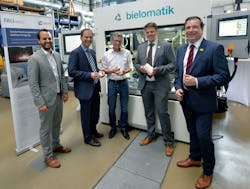FAB-Weld project examines welding processes for additive manufacturing

Large-format components produced via selective laser sintering (SLS) are desirable, but their size still is restricted by the given size of currently used build chambers. The three-year joint research project FAB-Weld now focuses on welding of parts produced using additive manufacturing to create individualized series components. Funded by the Bavarian Research Foundation, the project pursues the goal of optimizing welding processes for plastic materials. Among the project partners are the Institute of Polymer Technology (LKT) at the University of Erlangen-Nuremberg, the FIT Additive Manufacturing Group (Lupburg, Germany), and BMW (Munich, Germany).
The FIT Additive Manufacturing Group, represented by its subsidiary Sintermask, will contribute to the project by sharing its long-term expertise in SLS, which is an ideal technology for manufacturing complex components from thermoplastic material. When compared to conventional technologies such as injection molding, SLS scores by its avoidance of costly molds, making SLS an economical alternative to produce individualized components of high geometrical freedom in small lot sizes.The FAB-Weld project is seeking practical solutions to compensate for the size limitation by specially optimized welding processes. When joining customer-specific SLS parts and standard injection-molded parts, as well as SLS parts with other SLS modules to achieve large-volume parts, this requires a high-strength, media-impermeable connection that best uses the same material as the actual parts.
Vibration welding and infrared welding were identified as promising assembling technologies. In the project, FIT will manufacture SLS sample parts and will determine mechanical key figures by analyzing the mechanical properties and behavior of the welded parts, with the help of testing and measuring technologies available in-house such as GOM scanning and CT scanning.
For more information, please visit fit.technology.
